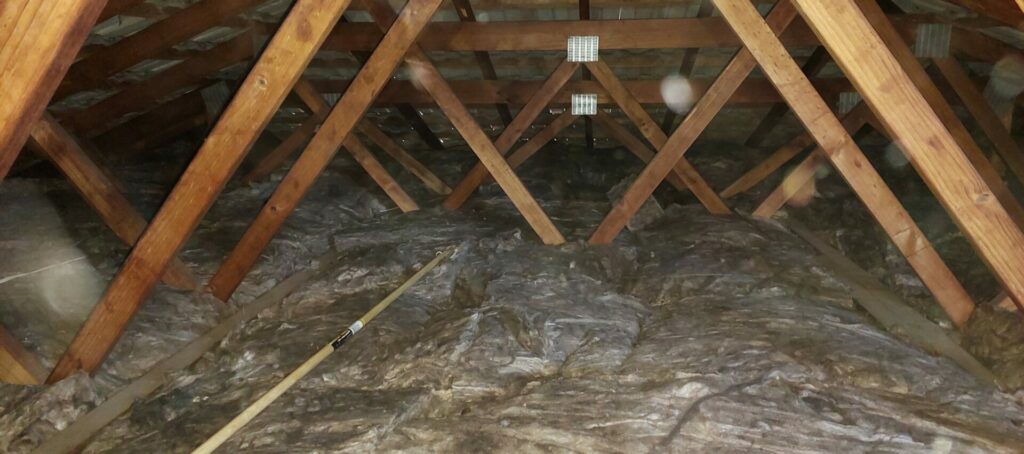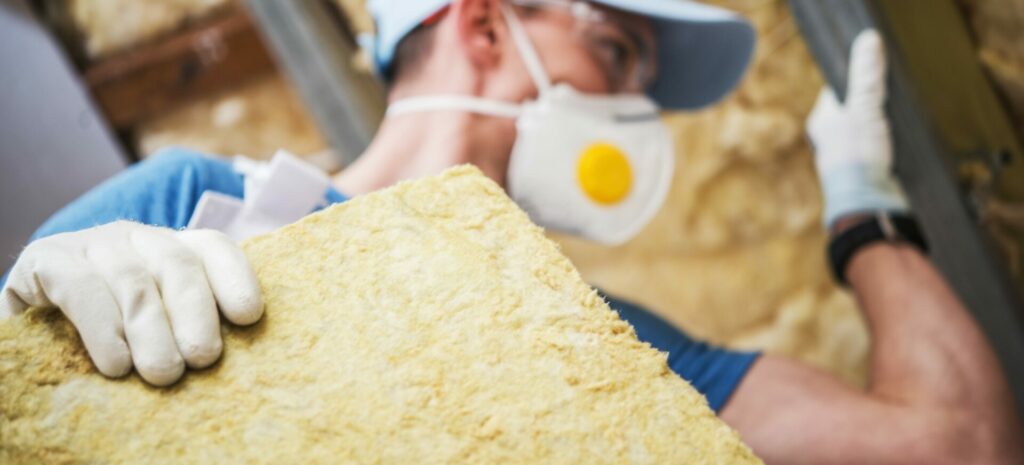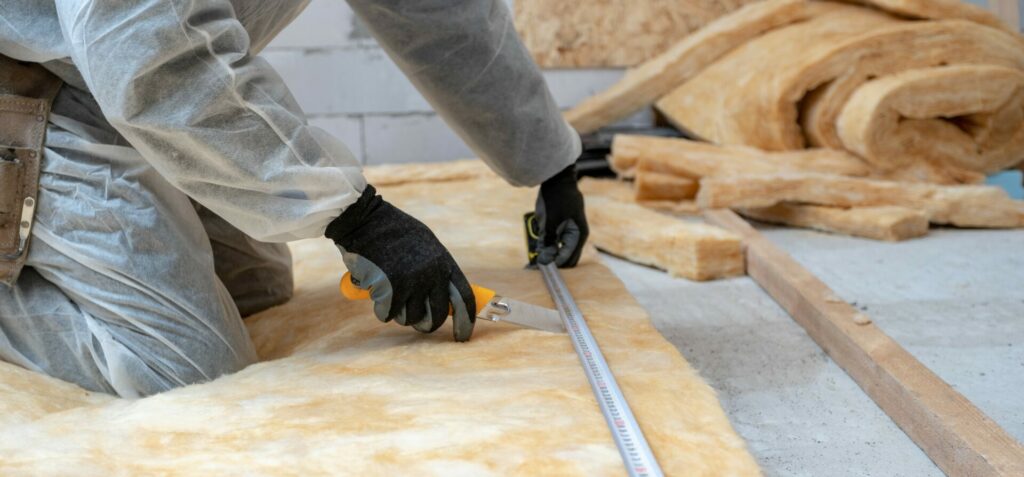When it comes to making your home more comfortable and energy efficient, one term you’re likely to encounter is “R-value.” But what exactly is insulation R-value, and why does it matter?
What is R-Value? R-Value Meaning
R-value, short for “thermal resistance value,” is a measure of an insulation material’s ability to resist the flow of heat. In simpler terms, it quantifies how effective a particular insulation product is at keeping your home warm in winter and cool in summer. The higher the R-value, the better the insulation’s performance. This is crucial to understand in a time where energy prices are rising and cost of living pressures are on a lot of people’s minds.
How Does R-Value Work?
As mentioned above, R-value relates to the insulation’s ability to resist heat transfer. To understand this concept better, let’s break down the mechanics of how insulation reduces heat transfer and achieves thermal resistance:
Trapping Air Pockets
Insulation materials, such as fibreglass, foam and cellulose, are engineered with a unique structure designed to trap tiny air pockets within them. These air pockets serve as insulating barriers. Here’s how it works:
- Fibreglass: This type of insulation consists of millions of fine glass fibres. The spaces between these fibres create air pockets. Fibreglass insulation is fluffy and lightweight, which allows it to trap air effectively.
- Foam: Foam insulations, like polyurethane foam, are composed of cells filled with air or another insulating gas. The closed-cell structure of foam insulation minimises heat transfer by restricting the transfer of heat between the cells.
- Cellulose: Made from recycled paper treated with fire retardants, cellulose insulation creates pockets of air within its fibrous structure. The trapped air minimises heat flow.
Conduction, Convection and Radiation
Heat transfer occurs through three primary mechanisms: conduction, convection and radiation.
Conduction
This is the transfer of heat through direct contact. When one part of a material gets hot (for example a hot cup of coffee) this is transferred directly through the ceramic cup and to your hand. Insulation materials (such as a thermos cup) slow down conduction by including a layer of trapped air in wall lining of the thermos cup.
Convection
Convection basically involves the heated molecules in warmer air, transferring kinetic energy to the cooler molecules. As with double glazed windows, insulation materials with trapped air pockets inhibit convection by restricting the movement of air within those pockets.
Imagine two adjoining rooms with closed door and windows on a warm summer day. In Room A the air-conditioner is turned on, and the room quickly cools down to a significantly lower temperature than the adjoining Room B. The kinetic energy in the warmer room B is now greater than in Room A, and the energy transfer process is immediately underway – from the warmer area to the cooler area. If the wall separating the two rooms is merely a sheet of plywood, then there is little to hinder the transfer of heat. However, if the wall is insulated, then this kinetic energy faces a significant obstacle – thousands or millions of tiny air-pockets within the thermal insulation effectively frustrate the high energy molecules from Room B from vibrating their way through and transferring energy to the cooler air in Room A.
Radiation
Radiation is the transfer of heat through electromagnetic waves. A good example of this is when sunlight shines onto a tin roof, heating it up to significantly more than the temperature of the air around it. Insulation materials with reflective surfaces are effective at blocking this form of heat transfer. Reflective insulation is typically installed on the opposite side of the heated surface, with a small air-gap – for example underneath the roof tiles of a house, or inside the walls of a metal shed. Reflective foil insulation reflects the heat back towards the heated surface, and as such is very effective at combatting the radiant heat emitting from the sun.

How Thick is Different Insulation of Different R-Value?
The thickness required varies depending on the insulation material’s R-value. For instance, a material with a high insulation R-value may require less thickness to achieve the same level of thermal resistance as a material with a lower R-value.
Higher performing insulation materials such as rigid foam boards or spray foam insulation, offer excellent thermal resistance compared to their relative thickness. This characteristic is particularly advantageous in applications where space is limited, such as extra tight wall cavities or cathedral ceilings.
In contrast, common bulk insulation such as fibreglass batts, rolls or loose-fill cellulose, typically require greater thickness to achieve the same level of thermal resistance. This means you may need to install thicker layers of these materials to reach the desired level of insulation effectiveness.
Is a Higher R-Value Always Better?
While a higher R-Value insulates better than a lower R-Value, how high you go will depend mainly on where you live.
Keeping in mind the basic principles of heat transfer as described earlier, ask yourself: What is the difference between the outside temperature where I live throughout the year – and a temperature which I’m comfortable with indoors? The greater the temperature differences, the higher the recommended insulation R-Value. With extreme weather conditions on the rise, an increasing number of Australian homes now require a higher R-Value insulation in order to remain comfortable indoors and to keep energy bills to a minimum.
What is Considered a Good R-Value?
The recommended ceiling insulation R-value in Australia generally falls within the range of R4.0 to R6.0, and home owners are increasing opting for an R5.0 or higher. Notably, under the ACT Government’s new minimum ceiling insulation standard, all significantly under-insulated rental properties will need to be upgrade to a minimum of R5.0. This was explained at a seminar for Canberra landlords in November, hosted by Morrell Property.
For underfloor insulation in Australia, the recommended R-value typically falls within the range of R1.5 to R3.0. These levels of insulation are considered suitable for most regions and climates across the country including all the major cities.
In earlier decades, it was quite common for new homes to be constructed without any insulation in the walls at all. Modern building standards now increasingly require at least a minimum level of wall insulation, and R-values of R2.0 and above are not considered excessive. When deciding the R-value of your wall insulation, keep in mind that it is extremely expensive to re-insulate a fully constructed wall, so if in doubt, err on the side of the higher R-Value!

Does Moisture Affect R-Value?
Yes, moisture can negatively impact R-value. In particular, bulk insulation materials such as glasswool and polyester insulation lose effectiveness when wet or damp, requiring an insulation removal and replacement to restore it’s original condition. Moisture can damage or disrupt the performance of insulation in several ways:
- Increased thermal conductivity. Moisture can significantly increase the thermal conductivity of many insulation materials. This means that heat can transfer more easily through wet or damp insulation. As a result, your heating or cooling systems have to work harder to maintain the desired temperature, leading to increased energy costs.
- Reduced insulation performance. Moisture can compress or compact insulation materials. When this happens, there’s less space for air pockets that provide the insulation’s resistance to heat flow. As a result, the R-value decreases, and your insulation becomes less effective.
- Mould and rot. Moist environments are a breeding ground for mould and mildew. When insulation gets wet and stays that way, it can foster the growth of these unwelcome guests. Mould not only reduces the R-value but also poses health risks and can damage your building’s structure.
To mitigate the negative effects of moisture on R-value, you have a few options:
- Select a more moisture-resistant insulation material. Some insulation materials are naturally more resistant to moisture. For example, closed-cell foam insulation is known for its resistance to water infiltration.
- Install vapour barriers. In areas where moisture is a concern, it’s a good idea to install vapour barriers. These are materials that are placed on the warm side of the insulation to prevent moisture from getting in.
- Proper ventilation. Ensuring proper ventilation in your home or building design can help manage moisture levels. This can include exhaust fans, whirlybird roof vents or crawl space vents, depending on the specific needs of your structure.
What Happens to R-Value if You Compress the Insulation?
Compressing insulation reduces its R-value. In fact, the more the insulation is compressed, the less effective it becomes. Insulation works by trapping air, and compressing it diminishes its ability to do so effectively. To put it in perspective, it’s like squeezing a sponge; when you compress it, it can’t hold as much water. Similarly, compressed insulation can’t hold as much “insulating air,” leading to a decrease in its R-value. So, if you’re looking to maintain the desired energy efficiency in your home or building, it’s crucial not to compress the insulation beyond what’s recommended.
Attempting to squeeze a e.g., 90mm wall insulation batt into a 70mm cavity will exert pressure on the wall lining and may cause it to bulge out, and is never recommended.
When installing insulation, it’s always wise to follow the manufacturer’s guidelines for proper installation. These guidelines specify the correct thickness and density to maintain the insulation’s intended R-value. Alternatively, you can opt to hire certified insulation installers who have the expertise and experience to ensure that your insulation is installed correctly, so it performs at its best and keeps your indoor environment comfortable and energy efficient.

The Verdict: Does R-Value Really Matter?
The short answer is yes. R-value plays a crucial role in ensuring your home remains energy efficient and comfortable. While it’s not the sole factor to consider, understanding insulation R-value and its context within your region’s climate and your home’s construction is vital for making informed insulation decisions.
Looking for a roof insulation inspection service or insulation installers in Canberra, Sydney or the Blue Mountains? Amelior Insulation’s communication and customer service are second to none, and we go out of our way to give our customers the best advice we can. Our professional underfloor and ceiling insulation installers take safety seriously and adhere to the insulation standards in Australia as far as quality workmanship is concerned.
Give us a call on 0450 858 568, or send a text requesting a call-back at a convenient time. We look forward to speaking with you and helping you with all your insulation needs!

